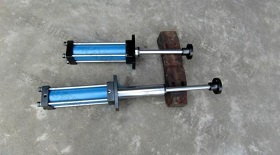The processing of hydraulic cylinder
Cylinder barrel is the main part of hydraulic cylinder, monomer pillar, hydraulic support, gun tube and so on. Cylinder processing requirements are high, the inner surface roughness requirements are Ra0.4 ~ 0.8 m, and coaxiality, wear resistance requirements are strict. The basic feature of cylinder barrel is deep hole machining, which always troubles the machining staff. More technology can be consulted.
By rolling, the residual compressive stress left on the surface layer is conducive to the sealing of tiny cracks on the surface and the expansion of erosion. Therefore, the surface anti-corrosion ability can be improved, and can delay the generation or expansion of fatigue cracks, improving the cylinder fatigue strength. By rolling forming, the rolling surface forms a cold hardened layer, which reduces the elastic and plastic deformation of the contact surface of the grinding pair, improving the wear resistance of the inner wall of the cylinder and avoiding the burn caused by grinding. After rolling, the surface roughness value decreases and the matching property can be improved.
Oil cylinder is the most important part of engineering machinery. The traditional processing method is: broaching cylinder body -- fine boring cylinder body -- grinding cylinder body. The rolling method is as follows: drawing the cylinder body -- fine boring the cylinder body -- roll the cylinder body, the process is 3 parts, but the comparison in terms of time: grinding the cylinder body for 1 meter is about 1-2 days, and rolling the cylinder body for 1 meter is about 10-30 minutes. Investment comparison: grinding machine or quilter (tens of thousands -- millions), rolling knife (one thousand -- tens of thousands). After rolling, the roughness of the bore surface is reduced from Ra3.2-6.3 to Ra0.4-0.8 μm before rolling. The surface hardness of the hole is increased by about 30% and the fatigue strength of the inner surface of the cylinder is increased by 25%. The service life of oil cylinder is increased by 2 ~ 3 times if only considering the influence of cylinder barrel. The above data indicate that the rolling process is efficient and can greatly improve the surface quality of the cylinder.
After the oil cylinder rolls, the surface has no sharp small blade, and the long motion friction will not damage the sealing ring or seal, which is particularly important in the hydraulic industry.



